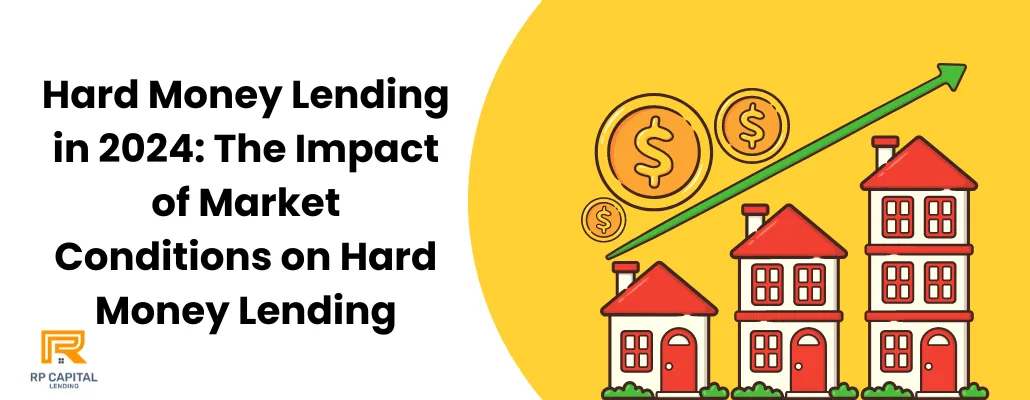Blog

Hard Money Lending in 2024: The Impact of Market Conditions on Hard Money Lending
Imagine a world where getting a loan is as easy as ordering a coffee. Welcome to the realm of hard money lending, a niche yet vital part of our financial ecosystem. This article will explore the dynamic relationship between market conditions and hard money lending, offering a comprehensive understanding for both borrowers and lenders.
Understanding Hard Money Lending
Definition and Basics
Hard money lending, a critical cog in the financial machine, is not your average loan process. It operates on a fundamental principle: loans are secured by real estate assets. This form of lending is the go-to for those who can't tread the traditional banking route, typically real estate investors or individuals in urgent financial need.
The allure of hard money loans lies in their simplicity and speed. Unlike traditional banks that wade through your credit history and financial health, hard money lenders focus on the value of the collateral. If the deal is good, the loan is almost yours. This swift and straightforward approach makes hard money lending a valuable tool, especially in time-sensitive investments.
How It Differs from Traditional Lending
Traditional lending and hard money lending are like two different planets in the financial universe. The former, represented by banks and credit unions, orbits around credit scores, income history, and financial stability. The latter, however, zooms in on the value of the property you're willing to put up as collateral.
This difference in focus is what sets them miles apart. Hard money loans are faster to obtain, often processed within days, a stark contrast to the weeks or even months taken by traditional loans. They're more flexible, with terms negotiated between lender and borrower. However, this flexibility comes at a cost: higher interest rates and shorter repayment terms. For investors looking for quick financing or those who can't meet traditional loan criteria, hard money lending is a viable alternative.
Market Conditions and Their Impact on Hard Money Lending
Economic Factors
The ebb and flow of the economy significantly sway the course of hard money lending. Interest rates, a heartbeat of the financial sector, are a key player. When they rise, hard money loans become more expensive, potentially slowing down the borrowing pace. Conversely, lower rates can stimulate this lending sector.
Economic downturns and upswings also play their roles. In recessions, traditional bank loans may become scarcer, leading borrowers towards hard money options. However, the increased risk during such times can lead to stricter lending criteria and higher rates by hard money lenders. In flourishing economies, while traditional lending may become more accessible, the speed and flexibility of hard money loans remain appealing, especially for time-sensitive real estate deals.
Real Estate Market Trends
Hard money lending is deeply intertwined with the real estate market's rhythm. A booming real estate sector can be a goldmine for hard money lenders, as rising property values increase collateral worth, enticing more lending. In these times, the market sees an influx of investors seeking quick financing for property flips or new developments.
On the flip side, a declining real estate market poses risks. The collateral value may drop below the loan amount, a scenario every lender avoids. It leads to a tighter lending environment, with lenders becoming more selective, often demanding higher interest rates to mitigate risk. Thus, understanding real estate trends is crucial for both lenders and borrowers in the hard money space to navigate these waters safely.
Advantages of Hard Money Lending in a Volatile Market
Speed and Flexibility
In the ever-changing tides of the financial world, the speed and flexibility of hard money lending shine. This is especially true in volatile market conditions where time and adaptability are of the essence. Hard money loans can be processed and disbursed in a matter of days, a stark contrast to the lengthy timelines of traditional banks.
This rapid turnaround is invaluable for real estate investors looking to capitalize on time-sensitive opportunities or for those who need urgent funding. Moreover, the flexibility in terms and conditions of hard money loans offers a tailored approach to financing, accommodating unique borrower situations and project needs. This agility in lending empowers borrowers to navigate through market uncertainties with more confidence.
Less Stringent Requirements
Hard money lending provides a lifeline in situations where traditional banking requirements become insurmountable barriers. For borrowers who may not have the perfect credit score or a stable income history, hard money loans emerge as a viable alternative. The focus on property value rather than personal financial history opens doors for a wider range of borrowers, including those with recent financial setbacks.
Additionally, for real estate projects that might not fit into the conventional lending frameworks due to their nature, timeline, or risk profile, hard money lenders often provide the needed funds. This aspect of hard money lending is particularly beneficial in a volatile market where traditional lending criteria might tighten, ensuring continued access to capital for diverse investment and emergency financial needs.
Risks and Challenges in Hard Money Lending
Interest Rates and Loan Terms
While hard money loans offer several advantages, they come with their own set of risks, primarily in the form of higher interest rates and more stringent loan terms. These loans often carry interest rates significantly higher than traditional loans, reflecting the increased risk taken on by the lender.
This can lead to a higher financial burden on the borrower, particularly if the investment does not yield the expected return or if the market conditions deteriorate. Additionally, hard money loans typically have shorter repayment terms, often requiring the borrower to pay back the loan within a year or two.
This can create pressure to quickly turn around an investment, which might not always be feasible, especially in a fluctuating market. Borrowers need to carefully assess these factors to ensure they can meet the repayment terms without exposing themselves to undue financial stress.
Market Volatility and Lender Risks
Market volatility adds a layer of complexity to hard money lending. For lenders, the primary risk lies in the value of the collateral—usually real estate—fluctuating with market conditions. In a declining market, the property securing the loan might lose value, leaving lenders with inadequate coverage for the loan amount. This scenario can lead to increased defaults and financial losses for lenders.
On the borrower's side, market downturns can hamper their ability to sell or refinance the property at a profit, leading to challenges in repaying the loan. Both lenders and borrowers must remain acutely aware of market trends and potential risks to navigate this terrain. It requires a balance of savvy investment strategies and careful risk assessment to ensure that the benefits of hard money lending are not overshadowed by the challenges posed by market volatility.
Navigating Regulatory Changes
Recent Regulatory Developments
The landscape of hard money lending is not just shaped by market conditions but also by evolving regulatory frameworks. Recent years have seen a shift in regulations governing private lending practices, including hard money loans. These changes aim to protect both borrowers and lenders, introducing more transparency and accountability into these financial transactions. For lenders, staying abreast of these regulatory changes is crucial to ensure compliance and avoid legal pitfalls. This might involve adapting their lending practices, documentation, and borrower assessment processes.
For borrowers, understanding these regulations is equally important, as it affects loan accessibility, terms, and their rights. The dynamic regulatory environment, therefore, necessitates that both parties stay informed and adaptable, ensuring that their hard money lending practices align with current legal standards.
Impact on Lenders and Borrowers
Regulatory changes in hard money lending have a tangible impact on both lenders and borrowers. For lenders, increased regulation often means more stringent documentation, enhanced due diligence, and potentially higher operational costs.
These changes can influence their lending criteria, affecting loan availability and terms. On the borrower's side, regulation can lead to better protection from predatory practices, ensuring fairer loan terms and clearer disclosure of loan conditions.
However, it can also result in reduced flexibility and availability of loans, particularly for borrowers with unconventional financial profiles. Ultimately, while these regulations aim to create a safer lending environment, they require both lenders and borrowers to be more diligent and informed about the nuances of hard money lending in a regulated landscape.
Investor Perspective: Opportunities in Hard Money Lending
Investment Strategies
From an investor's standpoint, hard money lending presents unique opportunities, especially in a volatile market. Investors can capitalize on the higher interest rates of these loans compared to traditional investments, leading to potentially higher returns. However, this comes with a need for strategic thinking. Successful hard money investors often diversify their portfolios across various real estate markets and borrower types to mitigate risk.
They also conduct thorough due diligence on potential borrowers and the underlying property to ensure the loan's security. In addition, understanding market trends and economic factors enables these investors to adapt their strategies accordingly, targeting loans that align with current market conditions and borrower needs. This proactive and informed approach is key to reaping the benefits of hard money lending while managing the inherent risks.
Risk Management
Effective risk management is crucial for investors in hard money lending. The primary risk involves the potential default of the borrower, which could lead to foreclosure proceedings. To mitigate this, investors often require higher down payments, ensuring a buffer in the loan-to-value ratio.
Regular monitoring of the borrower's financial status and the property's condition is also vital to identify any red flags early. Additionally, diversifying investments across different types of properties and geographical locations can reduce the impact of market fluctuations on the overall portfolio. Investors also stay informed about regulatory changes and market trends to adapt their lending criteria and terms accordingly.
By employing these risk management techniques, investors can safeguard their investments in hard money lending, balancing the high-reward potential with prudent financial practices.
Borrower's Perspective: When to Consider Hard Money Loans
Suitable Scenarios for Borrowers
For borrowers, hard money loans are a valuable option in specific scenarios. These include situations where quick funding is required, such as in real estate transactions involving bidding wars or time-sensitive investment opportunities. Hard money loans are also ideal for borrowers unable to secure traditional financing due to credit issues or unconventional income sources. Real estate investors looking to renovate and flip properties often prefer hard money loans for their speed and flexibility. Additionally, these loans can be a temporary solution for those needing to bridge a financial gap while securing long-term financing. Understanding when and how to use hard money loans can be a strategic financial move for borrowers, allowing them to leverage opportunities that would otherwise be inaccessible.
Comparison with Other Financing Options
When considering financing options, it's important for borrowers to compare hard money loans with traditional bank loans and other lending alternatives. Hard money loans typically offer quicker approval and funding, with less emphasis on credit history, making them suitable for urgent or non-conventional funding needs. However, they come with higher interest rates and shorter repayment terms, which can pose a greater financial burden.
Traditional bank loans, while offering lower interest rates and longer repayment terms, require a thorough credit and financial background check, making them less accessible for some borrowers. Other alternatives like peer-to-peer lending or online lenders may offer a middle ground, with relatively fast processing times and more flexible criteria than banks, but usually with higher interest rates than traditional loans.
Each option has its pros and cons, and the choice depends on the borrower's specific needs, financial situation, and the urgency of the funding requirement.
Future Outlook of Hard Money Lending
Predictions and Trends
The future of hard money lending appears poised for evolution, influenced by market trends and technological advancements. Industry experts predict a continued rise in the popularity of hard money loans, driven by their flexibility and the increasing demand for rapid financing solutions in the real estate market.
Technological integration is expected to further streamline the lending process, making it faster and more accessible. Additionally, the growing trend towards more transparent and borrower-friendly practices could lead to a broader acceptance of hard money lending. However, potential economic fluctuations and regulatory changes remain pivotal factors that could shape the trajectory of this industry.
Keeping an eye on these trends will be crucial for both lenders and borrowers to navigate the future landscape of hard money lending effectively.
Impact of Ongoing Market Changes
Ongoing market changes, such as fluctuations in interest rates, real estate market dynamics, and economic cycles, will continue to impact hard money lending. In bullish real estate markets, we may see an uptick in hard money lending as investors seek quick financing to capitalize on market opportunities.
Conversely, in bearish markets, while the demand for hard money loans might increase due to the tightening of traditional credit, lenders may become more cautious, adjusting their lending criteria to mitigate risk. Additionally, technological disruptions and potential regulatory reforms could influence lending practices and accessibility.
Staying adaptable and informed will be key for those engaged in hard money lending to leverage opportunities and mitigate risks associated with these ongoing market changes.
Conclusion
In conclusion, hard money lending emerges as a vital, albeit complex, facet of the financial landscape, particularly in real estate. Its appeal lies in the speed, flexibility, and accessibility it offers, making it a crucial tool for certain borrowers and investors, especially in fluctuating market conditions. However, the higher costs, inherent risks, and evolving regulatory environment demand careful consideration and informed decision-making. As this sector continues to evolve with technological advancements and market changes, both lenders and borrowers must stay informed and adaptable. Ultimately, hard money lending, when navigated wisely, can offer substantial opportunities in the dynamic world of finance.
FAQs
1. What is Hard Money Lending?
It's a type of loan secured by real property, offered by private lenders or investors.
2. When Should One Consider a Hard Money Loan?
It's ideal for quick financing needs, real estate investments, or when traditional financing is not an option.
3. How Do Market Conditions Affect Hard Money Lending?
Economic factors and real estate trends can impact interest rates, loan availability, and risk factors.
4. What Are the Risks Involved in Hard Money Lending?
Higher interest rates, potential for property value fluctuations, and shorter repayment terms.
5. Is Hard Money Lending Regulated?
Yes, but regulations vary by state and are generally less stringent than traditional banking.
Disclaimer: Loans only apply to non-owner occupied properties. Rates, terms and conditions offered only to qualified borrowers, may vary upon loan product, deal structure, other applicable considerations, and are subject to change at any time without notice.
Copyright © 2025. All Rights Reserved.


